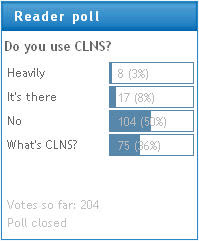Category: CLNP
On the Usability of OSI Layered Networking Model
Two weeks ago I replied to a battle-scar reaction to 7-layer OSI model, this time I’ll address a much more nuanced view from Russ White. Please read his article first (as always, it’s well worth reading) and when you come back we’ll focus on this claim:
The OSI Model does not accurately describe networks.
Like with any tool in your toolbox, you can view the 7-layer OSI model in a number of ways. In the case of OSI model, it can be used:
Duty Calls: Technologies that Didn't: CLNS
Russ White published an interesting story explaining why we’re using IP and not CLNS to build today’s Internet.
Let’s start with a few minor details he missed that I feel obliged to point out (apologies to Russ for being too pedantic, but you know me…):
Response: The OSI Model Is a Lie
Every now and then I stumble upon a blog post saying “OSI 7-layer model sucks” or “OSI 7-layer model is a lie”, most recent one coming from Robert Graham.
Before going into the details, let’s agree on the fundamentals.
Most everyone who ever tried to build a network spanning more than one transmission technology and including intermediate nodes came to the conclusion that layered approach to networking makes sense.
Whether you have three, four, five, or seven layers in your model doesn’t matter. What really matters is that your model contains all the functionality you need to implement host-to-host networking in target environment.
Could You Use IS-IS Instead of BGP for Routing on Hosts?
One of my readers sent me an interesting question a while ago:
Isn’t IS-IS a better fit for building L3-only networks than BGP, particularly considering that IS-IS already has a protocol to communicate with the end systems (ES-IS)?
In theory, he’s correct (see also this blog post).
Was CLNP Really Broken?
One of my readers sent me this question after listening to the podcast with Douglas Comer:
Professor Comer mentioned that IP choose a network attachment address model over an endpoint model because of scalability. He said if you did endpoint addressing it wouldn’t scale. I remember reading a bunch of your blog posts about CNLP (I hope I’m remembering the right acronym) and I believe you liked endpoint addressing better than network attachment point addressing.
As always, the answer is “it depends” (aka “we’re both right” ;).
Layer-3-Only Data Center Networks with Cumulus Linux on Software Gone Wild
With the advent of layer-3 leaf-and-spine data center fabrics, it became (almost) possible to build pure layer-3-only data center networks… if only the networking vendors would do the very last step and make every server-to-ToR interface a layer-3 interface. Cumulus decided to do just that.
Reinventing CLNS with L3-only Forwarding
Hank left a lovely comment on my Rearchitecting L3-Only Networks blog post:
What you describe is literally intra-area routing in CLNS.
He’s absolutely right (and I admitted as much during my IPv6 Microsegmentation presentations @ Troopers 15).
CLNP and the Multihoming Myths
When IESG decided to adopt SIP, not TUBA (TCP/UDP over CLNP) as IPv6, a lot of people were mightily disappointed and some of them still propagate the myths how CLNP with its per-node addresses would fare better than IPv6 with its per-interface addresses (you might find the writings of John Day on this topic interesting and Petr Lapukhov is also advocating this view in his comments).
These views are correct when considering small-scale (intra-network) multihoming, but unfortunately wrong when it comes to Internet-scale multihoming, where CLNP with TCP on top of it would be as bad as IPv4 or IPv6 is (routing table explosion due to multihoming is also one of the topics of my Upcoming Internet Challenges webinar).
Can we go back to CLNP?
Paulie, a frustrated enterprise IPv6 early adopter summarized his pains in a comment to my “Small-site multihoming in IPv6: mission impossible?” post saying “[IPv6/IPv6 support] is a mess and depressing” and asked “Is it too late to go to CLNS?”
Quite a few old-timers (I’m definitely one of them) lament the glory days of VMS, DECnet Phase V and CLNP, but while CLNP was a viable alternative for the next-generation IP in 1993, it would fare worse than IPv6 today.
CLNS and CLNP
Yap Chin Hoong has been looking at the OSI protocol stack I’ve published and asked an interesting question: “where is CLNS in that protocol stack?”
The OSI protocol stack has a major advantage over the TCP/IP stack: it defines both the protocols and the APIs between the layers. CLNS (Connection-less network Service) is the API (the function calls that allow transport layers to exchange datagrams across the network) while CLNP (Connection-less network Protocol) is the layer-3 protocol that implements CLNS. In my diagram, CLNS would be a thin line above CLNP between L3 and L4 boxes.
… updated on Saturday, December 26, 2020 09:06 UTC
IS-IS Is Not Running over CLNP
Numerous sources on the Internet claim that IS-IS runs on top of OSI’s Connectionless Network Protocol (CLNP). This is not the case; although IS-IS and CLNP share the same layer-2 Service Access Point (SAP), OSI provides an additional field (Network Layer Protocol Identifier; NLPID) in the first byte of the layer-3 header.
Contrary to the IP world where the identification of layer-3 protocol is based on Ethertype or PPP protocol ID, the identification of a layer-3 OSI protocol is performed based on layer-2 Service Access Point (DSAP = 0xFE) and the first byte of the layer-3 header, which has the following values:
What Is CLNS?
According to the results of my recent Do you use CLNS poll, around 10% of my readers use CLNS in their network, while 36% of them wonder what that acronym stands for.

Let's start with the acronyms. CLNS (Connection-Less Network Service) in combination with CLNP (Connection-Less Network Protocol) is the ISO (International Standards Organization) equivalent to IP.
